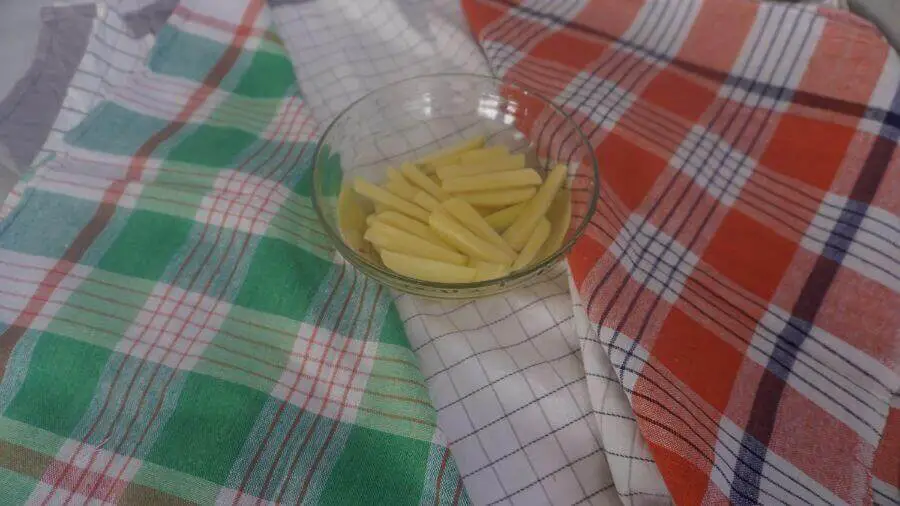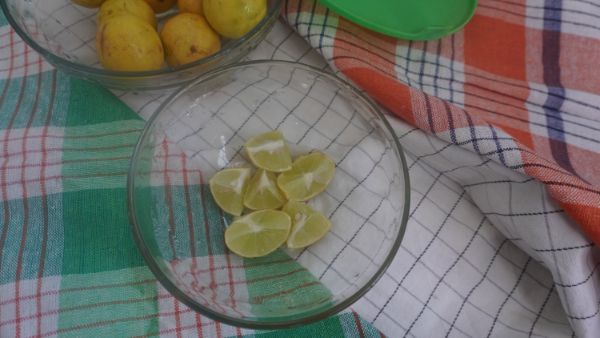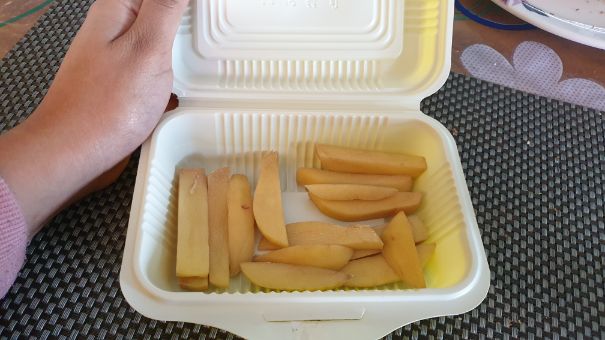When potatoes were first introduced in Europe in the 1500s, it took people almost two centuries to acquire a taste for this starchy vegetable. But today, it’s hard to imagine any cuisine without potatoes, isn’t it?
This humble vegetable is delicious as a stand-alone dish but also works exceptionally well when used in hot pies, chowder, and so much more.
Most recipes call for potatoes to be peeled and cut. And yes, it’s as cumbersome as it sounds. So, I’m often left wondering how to store cut and peeled potatoes?
In this blog, we will discuss everything there’s to know about storing peeled and cut potatoes the correct way. I carried out small experiments to find out – Here’s the result.
Table Of Content
How To Store Cut And Peeled Potatoes?
You should store cut and peeled potatoes in cold water in the fridge to prevent them from turning brown due to oxidation. Make sure the entire potato is fully submerged in the water. If any part is exposed to the air, it will first turn pinkish-red and then brown.
Keeping potatoes submerged in water is the tried and tested method of preventing them from going dark. But why does that happen in the first place?
That’s because potatoes are starchy vegetables. And when starch reacts with oxygen, it leads to oxidation. The potatoes are still entirely edible but less appetizing, aren’t they?
You Only Have 24 Hours

Yes, you only have 24 hours to put them potatoes to good use. After that, the starch will turn into sugar, courtesy of cool refrigerator air – not only making them less healthy in the process but also causing texture and flavors to change.
Unless you’re going to use the soaked produce to make mashed potato, don’t soak for any longer than 24 hours. If you do, the poor potatoes will be unable to maintain their structure.
Acid To The Rescue

Placing potatoes in water will slow the oxidation process but not stop it entirely. So, if you need your spuds to remain in the water for more than 6 hours, like overnight, add a dash of acid.
You can use lime juice, lemon juice, or white vinegar to lower the potatoes’ pH to fight oxidation. Use just one teaspoon per half a gallon of water to fight oxidation for overall protection without compromising flavors.
My Little Experiment | Part 1 | A Myth-Buster?
I knew you were supposed to immerse cut/peeled potatoes in water. But curiosity got the best of me. And guess what’s next? Curiosity killed the cat.
So, for the sake of this article, I prepped some cut and peeled potatoes and locked them in an airtight container. I then put the container in the fridge’s crisper section for 5 hours.
Result?

Nor a single spot. I then checked the potatoes again after a couple of days, this is what they looked like.
I was taken by surprise. I had read that closed containers like an airtight box or resealable container trap moisture and cause the potatoes to mold and spoil at a much faster pace.
But my potatoes were as good as freshly cut potatoes, I don’t know why and how it worked, but I wouldn’t still recommend storing them this way just to err on the side of caution.
This is what they looked like after 10 days. They had gotten slightly darker but no spots yet.

Anyway, I cooked them and made mashed potatoes. They tasted perfectly fine.
My Little Experiment | Part Two
Salt is used almost ubiquitously in all preservation methods globally. So, I decided to experiment. Yes, I added a pinch of salt to the water I would dip the potatoes in. I then put the container in the fridge.
No point for guessing what happened. The water turned dark brown, and the potatoes became soft and flimsy. Turns out that this happens because salted water moves out of the potato.
Keep This Tip In Mind
The larger the cut potato pieces, the longer they can stay submerged in the water. If the potato pieces are too small, they have considerably less time they can withstand soaking.
If you’re going to make recipes that need the potatoes to be finely diced, shredded, or sliced, you’re better off prepping them the same day.
Be Careful!
Hot oil and wet veggies don’t mix well. So, please make sure the potato pieces are dry before you dip them into the oil. And if the recipe you’re making calls for the finished potatoes to be extra crispy, avoid soaking them in the first place.
How To Tell If The Potatoes Have Gone Bad?
If the potatoes become soft, shriveled, and wilted, they have most likely gone bad. They may also give off a musty, funky smell.
Keep in mind that green sprouts don’t indicate spoilage. However, they do suggest that the nutrients are leaving the potato. So, make sure you use them.
Now that it’s clear that cut and peeled potatoes should be submerged in water but not for more than a day, let’s quickly go through some other frequently asked queries on potatoes at Cooking Yoda.
Can You Freeze Cut And Peeled Potatoes?
Yes, you can freeze cut and peeled potatoes for at least a month. Once blanched and drained, lay them on a baking sheet lined with parchment paper and freeze them until completely solid and frozen. Next, toss the frozen potatoes in a freezer-safe bag, and squeeze out as much air as possible.
Don’t forget to label the bags with the date before finally freezing them. The original flavor and texture will be retained for at least a month.
Food and Wine reports that frozen potatoes blanched and drained before freezing will last for a year in the freezer.
While at it, let me tackle one more question.
How To Store Cooked Potatoes In The Freezer?
You can store cooked potatoes in the freezer just like raw but peeled and cut potatoes. First, freeze them on a parchment paper-lined baking sheet until solid. Next, toss them in a freezer-safe bag and put it back into the freezer.
You’d be happy to know that cooked potatoes fare pretty nicely in the freezer, especially the low-starch varieties, like Yukon Golds and red potatoes. High-starch potatoes, like baking potatoes and russets, also can be frozen, but they will become a bit grainy when you thaw and reheat.
Choosing The Right Kind Of Potatoes
Not all potatoes are made the same. Some can withstand being frozen longer than others. Waxy varieties like Yukon Golds and red potatoes fare the best since they’re lower in starch.
It’s not like you can’t use high-starch varieties like Yukon Golds and russets, but these tend to be grainy during the thawing and reheating processes.
And one more.
How To Thaw Frozen Potatoes?
You can thaw frozen potatoes on a stovetop in a saucepan or slow cooker at low heat. They can also be defrosted in the microwave and oven.
Keep Reading!
How To Store A Cut Lemon? Wrap In Plastic?
